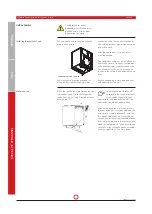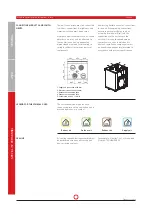
OPERATING AND INSTALLATION INSTRUCTIONS LG 250 A
PAGE 28
Changes reserved
U
S
ER
G
ENER
A
L
S
P
EC
IA
LIS
T
P
ER
S
O
NNEL
1. "MINI" control unit
The “MINI“ control unit, installed in the
living area, is used to easily control the
ventilation unit. Its ease of operation
enables the manual setting of ventilation
levels, switching between summer and
winter modes, the setting of base volume
flows, etc. The mode and current faults
are also displayed.
2. "TOUCH" control unit (optional)
The “TOUCH“ control unit is easy to use
and provides an overview via a TFT touch
display. It should be installed at a location
in residential buildings so that users
have access to control and an overview
of messages at all times. The integrated
temperature sensor records the current
ambient temperature and ensures that
supply air is regulated correctly.
3. Output component
The output component installed in the
ventilation unit is used by the installer or
service technician to set the individual
operating parameters, based on the
respective on-site application. The
settings can be made either using the
operating unit or via a PC interface and
communications software.
4. Connecting cable J-Y(ST)Y2x2x0.8
A screened cable Y(ST) YYx2x0.28 is
required to establish a connection and for
communication between the control unit
and control board. Cable length must not
exceed 100 m.
5. Filter ODA ISO ePM2,5 65% (outdoor
air), optional filter ODA ISO ePM1 80%
The outdoor air filter filters dust and dirt
from the outdoor air.
6. Filter ETA ISO Coarse 90% (extract
air), optional filter ETA ISO ePM10 75%
Coarse contaminations are filtered out of
the extract air via the extract air filter.
7. Counterflow heat exchanger
The efficient heat exchanger extracts
the energy content from the extract air
and transfers this to supply air. Optional
enthalpy exchanger available.
8. Condensate drain
Condensate generated during the
operation of the heat exchanger is
directed into the condensate tray.
The connected condensate drain, which
passes through an effective odour trap
(siphon), drains the generated condensate.
9. Frost protection heating with PTC
low temperature preheater battery
(optional)
Used to prevent the condensate from
freezing in the heat exchanger at very
low exterior temperatures. The optional
electric PTC low temperature preheater
battery preheats the outdoor air based on
the outdoor and exhaust air temperatures.
When an optional water battery
or brine battery is used to
provide frost protection for the
heat exchanger, this must be provided
with appropriate frost protection.
10. Bypass flap with servo motor
Used in Summer mode to transfer the
air flow to the heat exchanger when the
outdoor air temperature is lower than the
room temperature.
11. Supply air fan
Ensures the air volume flow for supply
air, directs processed outdoor air into the
living area.
12. Exhaust air fan
Ensures the air volume flow for exhaust
air, directs used air from the building into
the open air.
13. Front cover with handwheel bolt
The front cover is easy to open for
maintenance on the unit. When replacing
the cover, ensure that it is completely
closed and that there is sufficient seal-
tightness between the front cover and the
unit housing.
14. Air pipe connections
Serve as a connection to the air pipe
system. Correct connection to supply air,
extract air, outdoor air and exhaust air
must be ensured during assembly.
15. Cable guides
The ventilation unit is normally supplied
complete with electrical wiring. The cable
guides are used to create the electrical
connections to connect the operating unit
with optional system accessories such as
temperature sensors, etc.
















































